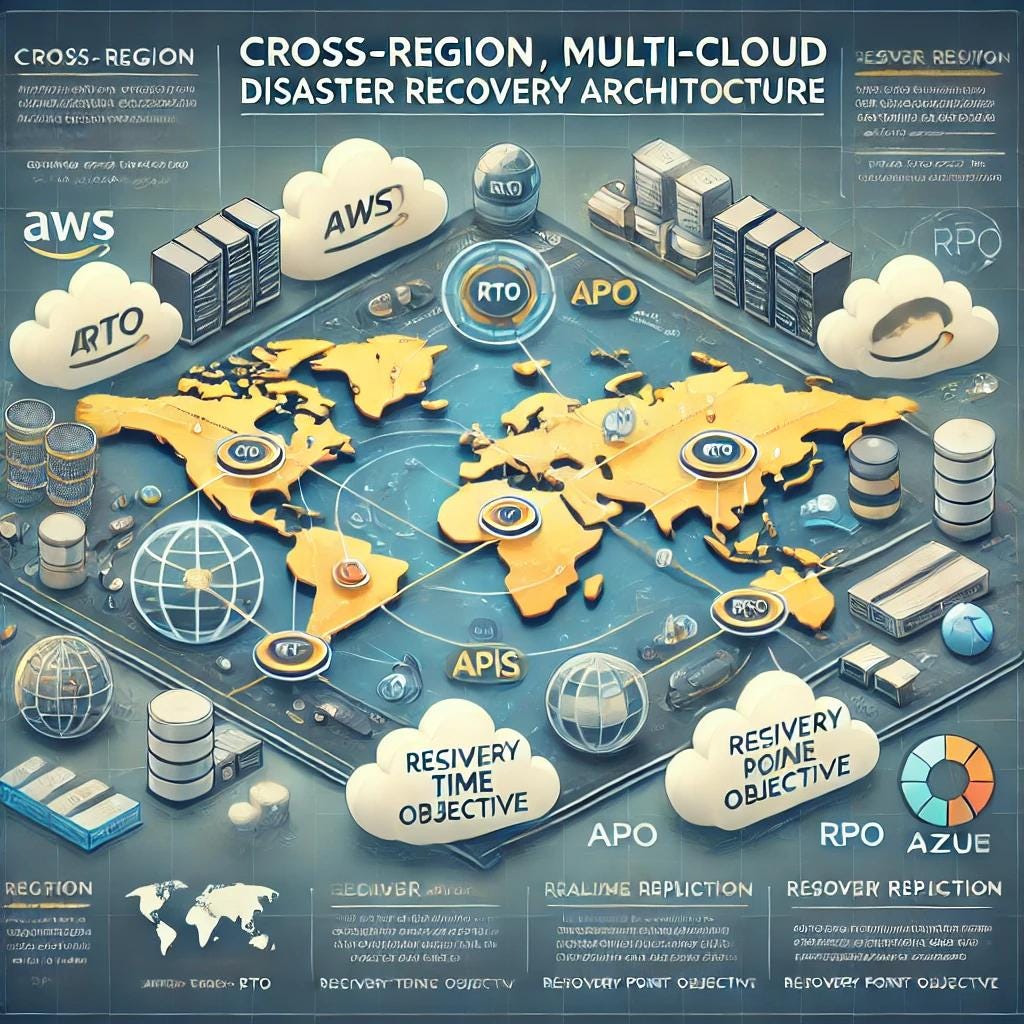Cross-Region Multi-Cloud Disaster Recovery
Ensuring high availability and resilience for critical applications is paramount. Disasters, whether caused by hardware failures, natural calamities, or cyberattacks, can severely impact business operations. To mitigate these risks, organizations are increasingly adopting multi-cloud disaster recovery (DR) strategies, leveraging the strengths of multiple cloud providers like AWS and Azure.
This guide will take you through designing and implementing a robust cross-region, multi-cloud disaster recovery solution for a critical application. It will cover every aspect of the process, from understanding disaster recovery requirements to architecting the solution, configuring data synchronization, implementing failover mechanisms, and validating the setup. By the end, you’ll have a clear roadmap for creating a system that ensures seamless recovery and high availability across different cloud environments. Whether you’re building for compliance, performance, or peace of mind, this approach equips you to handle the complexities of multi-cloud DR with confidence.
Disaster Recovery Requirements
Designing a disaster recovery (DR) solution begins with a thorough understanding of the application’s requirements and constraints. A clear grasp of these foundational aspects ensures that the solution is tailored to meet business needs, minimize downtime, and reduce data loss during disasters. This step involves identifying critical components, defining recovery objectives, and considering compliance and budgetary factors.
Step 1: Identify Critical Application Components
The first step is to determine which parts of the application are mission-critical and require prioritization during recovery. Applications often consist of multiple interconnected components, such as databases, application servers, APIs, storage systems, and external dependencies. To ensure an effective disaster recovery plan:
List all components: Create a detailed inventory of the application architecture, including primary services, dependencies, and supporting infrastructure.
Prioritize services: Classify components based on their importance to business continuity. For example, databases and APIs might be considered high-priority, while secondary analytics services may have lower urgency.
Map dependencies: Document the interdependencies between components. This step ensures that recovering one component does not fail due to missing prerequisites, such as database connectivity or storage access.
Step 2: Define Recovery Objectives
To ensure a measurable and practical disaster recovery strategy, two key metrics must be defined: the Recovery Time Objective (RTO) and the Recovery Point Objective (RPO).
Recovery Time Objective (RTO): This defines the maximum acceptable downtime for the application during a disaster. For example, an e-commerce application might have an RTO of one hour to avoid significant revenue loss.
Recovery Point Objective (RPO): This metric defines the maximum acceptable amount of data loss measured in time. For instance, an RPO of 15 minutes means that data generated within the last 15 minutes before a failure may not be recoverable but is deemed acceptable by the business.
Engaging with stakeholders, including business leaders and technical teams, is critical to accurately define these objectives. The RTO and RPO values directly influence the choice of DR architecture and synchronization mechanisms.
Step 3: Consider Compliance and Budget Constraints
Disaster recovery plans must align with regulatory requirements, contractual obligations, and financial limitations.
Compliance Requirements: Many industries are subject to regulations that mandate specific DR measures, such as data residency, encryption, or recovery capabilities. Examples include GDPR for European organizations or HIPAA for healthcare applications. Non-compliance can lead to penalties or reputational damage.
Budget Considerations: Disaster recovery solutions can range from low-cost backup strategies to high-cost, real-time failover systems, and establishing a budget ensures the solution is both effective and financially sustainable; for example, low-cost options include periodic backups to a secondary region, while higher-cost solutions involve active-active architectures with real-time data replication.
Risk Assessment: Balance the investment in disaster recovery against the potential risks and costs of downtime or data loss. High RTO/RPO requirements may justify larger investments, while less critical applications might opt for more cost-effective approaches.
You should have a understanding of the application’s disaster recovery needs. The deliverables include:
A comprehensive list of critical application components and their dependencies.
Clearly defined RTO and RPO metrics, agreed upon by key stakeholders.
A document outlining compliance requirements, risk assessments, and the DR budget.
With these elements in place, you’re ready to move on to designing a multi-cloud DR architecture that ensures high availability and seamless recovery across regions.


